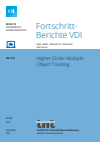Zusammenfassung
This dissertation deals with camera-based offline multiple object tracking and explores higher-order data association models. Due to their extensive exploitation of the available information, such models are promising approaches in current research. However, they commonly represent NP-hard optimization problems so that their application in practice is challenging.
The first part of this thesis proposes a binary quadratic program that enables to globally fuse signals within a higher-order data association model. This enables to overcome weaknesses of the individual signals. An approximate solver based on the Frank-Wolfe algorithm is presented and analyzed. Its benefit is demonstrated in two setups: fusion of two detectors and combining signals coming from a video and body-worn inertial measurement units. The second part of this thesis proposes an extension of the disjoint path model by higher-order information and connectivity priors, resulting in a binary linear program. Efficient separation algorithms are proposed and integrated into a cutting-plane algorithm, making it possible for the first time to solve higher-order data association globally in practice.
Contents
1 Intro...
Schlagworte
Verfolgung Mehrerer Objekte Binäres Lineares Programm (BLP) Binäres Quadratisches Programm (BQP) Datenassoziationsmodel Höherer Ordnung Globale Optimierung Video Sensorfusion Inertiale Messeinheit Multiple Object Tracking Binary Linear Programming (BLP) Binary Quadratic Programming (BQP) Higher-Order Data Association Model Global Optimization Sensor Fusion Inertial Sensors- Kapitel Ausklappen | EinklappenSeiten
- 1–32 1 Introduction 1–32
- 33–79 2 Fundamentals 33–79
- 130–164 4 Lifted Disjoint Paths 130–164
- 165–171 5 Conclusions 165–171
- 172–196 Bibliography 172–196

